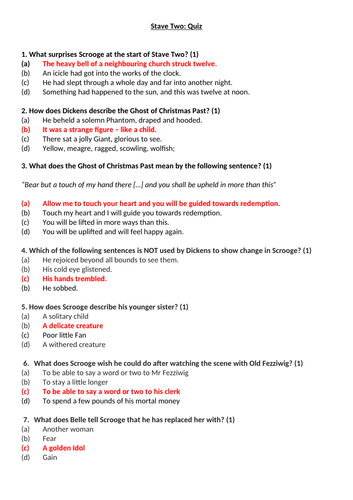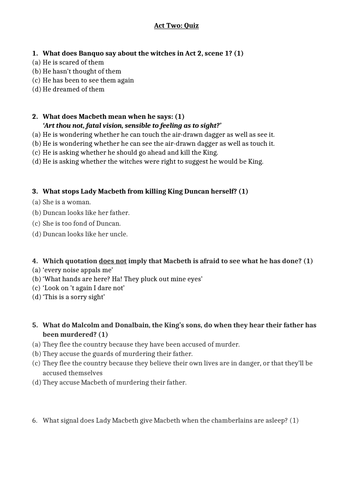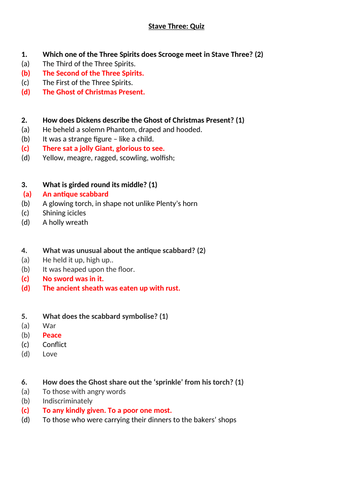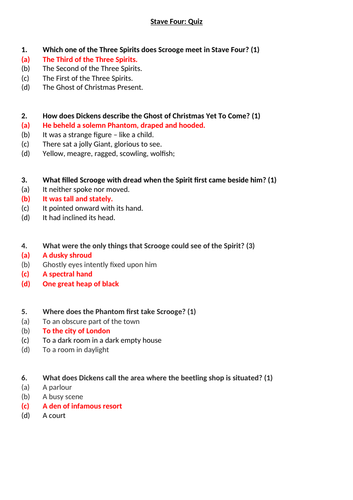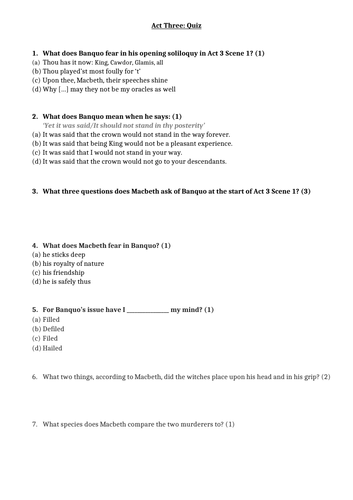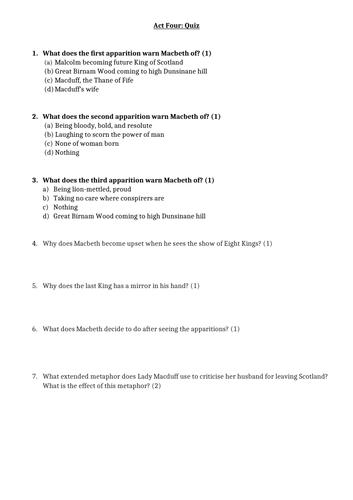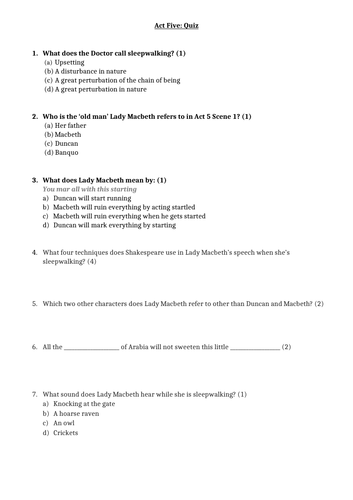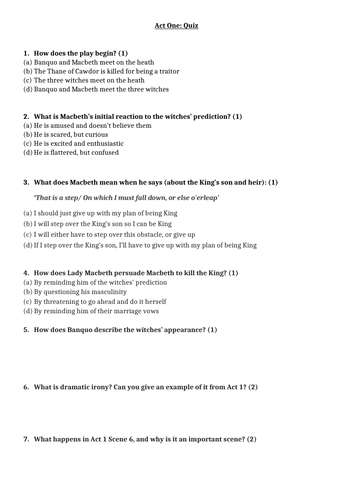67Uploads
23k+Views
8k+Downloads
All resources

A Christmas Carol Stave 2 Quiz and Answers worksheet
A Christmas Carol Stave 2 Quiz and Answers worksheet
A post-reading resource or revision activity to check understanding of Stave 2. Pupils can peer or self-assess using the answers sheet which can be read out by teacher, projected or printed.
Worksheet includes:
15 multiple choice questions on 2 A4 pages - pupils to select options a) b) c) d)
Questions cover a range of topics from basic comprehension, to inference, to grammar, quotation recall, and contextual understanding.
Also included, the answers worksheet where correct answers are highlighted in red.

English Homework - Verb Tenses
5 weeks’ worth of homework activities in an A4 Powerpoint editable and printable booklet.
Easy and quick to peer or self-assess in class.
Tasks focus on the following:
Homework 1 – Identifying verbs
Complete the clauses
Underline the verbs
Homework 2 – Present and past tense
Turn to the past tense
Turn present to past
Homework 3 – Correcting tenses
Rewrite the sentences using the correct verb tenses
Homework 4 – Correcting tenses
Rewrite the sentences using the correct verb tenses
Homework 5 – Correcting tenses
Rewrite the sentences using the correct verb tenses

Macbeth Act 2 Quiz and Answers worksheet
Macbeth Act 2 Quiz and Answers worksheet
A post-reading resource or revision activity to check understanding of Act 2. Pupils can peer or self-assess using the answers sheet which can be read out by teacher, projected or printed.
Worksheet includes:
12 questions on 2 A4 pages - pupils to select options a) b) c) d) or write the answers in the space provided.
Questions cover a range of topics from basic comprehension, to inference, to grammar, quotation recall, and contextual understanding.
Answers are included on a separate page.

Unseen Poetry - Lesson 2 (Understand and respond)
LO: How do I read, understand and respond to an unseen poem?
A complete lesson including starter, unseen poem, exam question, model responses, plenary that explores a Paper 2-style AQA English Literature unseen poetry question based on the following poem: William Blake:* A Poison Tree*.
These resources can be adapted for use with different poems and questions by other exam boards.
Powerpoint: 13 slides.
AQA English Lit Paper 2 Section C Unseen Poetry
Purpose of unit of work: To master questions 27.1 and 27.2
Form: Exam paper responses
Assessment Objectives:
AO1 - Read, understand and respond to texts, maintaining a critical style and developing an informed personal response, using textual references including quotations to support and illustrate interpretations (12 marks).
AO2 - Analyse the language, form and structure used by a writer to create meanings and effects, using relevant subject terminology where appropriate (12 marks).
AO2 - Comparison of AO2 (8 marks)
STIMULATE AND GENERATE
Focus on engagement, discussion and building cultural capital
CAPTURE, SIFT AND SORT
Sifting the outcomes from the first phase to fit where we are heading. What skills do pupils need to learn in order to be successful in the next phase?
Focus on teaching, modelling and developing key skills and processes linked to success criteria
CREATE, REFINE AND EVALUATE
More independent application of skills learnt. This is the stage that needs most differentiation and allows/enables writers to work at different rates and pitches. Self, peer and teacher review happens throughout this phrase.
Write extended responses to exam questions, provide feedback and refine work
Starter: How many links can you make between these two images? (Anger/Tree)
Key question: What might happen if you dwell on a negative emotion rather than dealing with it?
Unseen poem: William Blake: A Poison Tree. Glossary
Exam question: In A Poison Tree, how does the poet present the speaker’s feelings about anger? – 7 steps to understanding an unseen poem AO1 and AO2.
How do I structure my unseen poetry essay?: Go through steps 1-5
The Introduction: 3 sentence model.
I DO: Model introduction
YOU DO: Use this model to help you write an introduction focusing on A Poison Tree.
SELF-ASSESSMENT: Use this model to help you improve your own introduction.
How do I write an analytical paragraph?: WHAT WHERE HOW WHY model. Model paragraph analysing language
YOU DO: Use this model to help you write your own paragraph analysing language.
Plenary: Peer Assessment - Read through your partner’s response. Highlight and annotate their response to show where they have demonstrated WHAT WHERE HOW WHY. Write a brief commentary below their work in which you explain the following: What went well (WWW). What do they need to do in order to improve? (EBI). Use your peer’s feedback to help you improve your response.

A Christmas Carol Stave 3 Quiz and Answers worksheet
A Christmas Carol Stave 3 Quiz and Answers worksheet
A post-reading resource or revision activity to check understanding of Stave 3. Pupils can peer or self-assess using the answers sheet which can be read out by teacher, projected or printed.
Worksheet includes:
10 multiple choice questions on 2 A4 pages - pupils to select options a) b) c) d)
Questions cover a range of topics from basic comprehension, to inference, to grammar, quotation recall, and contextual understanding.
Also included, the answers worksheet where correct answers are highlighted in red.

A Christmas Carol Stave 5 Quiz and Answers worksheet
A Christmas Carol Stave 5 Quiz and Answers worksheet
A post-reading resource or revision activity to check understanding of Stave 5. Pupils can peer or self-assess using the answers sheet which can be read out by teacher, projected or printed.
Worksheet includes:
13 multiple choice questions on 2 A4 pages - pupils to select options a) b) c) d)
Questions cover a range of topics from basic comprehension, to inference, to grammar, quotation recall, and contextual understanding.
Also included, the answers worksheet where correct answers are highlighted in red.

A Christmas Carol Stave 4 Quiz and Answers worksheet
A Christmas Carol Stave 4 Quiz and Answers worksheet
A post-reading resource or revision activity to check understanding of Stave 4. Pupils can peer or self-assess using the answers sheet which can be read out by teacher, projected or printed.
Worksheet includes:
13 multiple choice questions on 2 A4 pages - pupils to select options a) b) c) d)
Questions cover a range of topics from basic comprehension, to inference, to grammar, quotation recall, and contextual understanding.
Also included, the answers worksheet where correct answers are highlighted in red.

Macbeth Act 3 Quiz and Answers worksheet
Macbeth Act 3 Quiz and Answers worksheet
A post-reading resource or revision activity to check understanding of Act 3. Pupils can peer or self-assess using the answers sheet which can be read out by teacher, projected or printed.
Worksheet includes:
15 questions on 2 A4 pages - pupils to select options a) b) c) d) or write the answers in the space provided.
Questions cover a range of topics from basic comprehension, to inference, to grammar, quotation recall, and contextual understanding.
Answers are included on a separate page.

Macbeth Act 4 Quiz and Answers worksheet
Macbeth Act 4 Quiz and Answers worksheet
A post-reading resource or revision activity to check understanding of Act 4. Pupils can peer or self-assess using the answers sheet which can be read out by teacher, projected or printed.
Worksheet includes:
12 questions on 2 A4 pages - pupils to select options a) b) c) d) or write the answers in the space provided.
Questions cover a range of topics from basic comprehension, to inference, to grammar, quotation recall, and contextual understanding.
Answers are included on a separate page.

AQA English Language Paper 2 Crib Sheet
Q2 - Q5 question formats, marks, timings, suggested response structures and suggested sentence openers
Printable colour A4 sheet on two sides including Q2, Q3, Q4 and Q5 (full page on reverse side)
Q2 – summary and inference
Q3 – language analysis
Q4 – comparison of views and perspectives
Q5 – non-fiction writing
Compact sheet which pupils can use in lessons to support writing exam responses. Also useful handout for pupils to use as quick revision tool leading up to exam.

English Homework - Sentences and Punctuation
English Homework - Sentences and Punctuation
6 weeks’ worth of homework activities in an A4 Powerpoint editable and printable booklet.
Easy and quick to peer or self-assess in class.
Tasks focus on the following:
Homework 1 – Identifying sentences
Label the subject and the verb in each sentence
Identify the sentences
Homework 2 – Simple or compound?
Turn the simple sentences into compound sentences
Identify whether the sentences are simple or compound
Homework 3 – Simple, compound or complex?
Turn the simple sentences into complex sentences
Identify whether the sentences are simple, compound or complex
Homework 4 – Demarcating sentences
Rewrite the sentences using correct punctuation
Homework 5 – Correcting punctuation
Rewrite the sentences using correct punctuation, removing comma splice or run-on sentence errors
Homework 6 – Colons and semicolons
Rewrite the sentences placing a colon where required
Rewrite the sentences placing a semicolon where required

Dr Jekyll and Mr Hyde: Chapter 1 difficult words or phrases explained in modern English
Stevenson’s vocabulary can be difficult for some pupils (and, at times, teachers too!). This powerpoint lists all those words and phrases that would typically present difficulties and offers easy translations into modern English, or into language that teenagers would more readily understand.
Just display on a projector during guided reading so that pupils can look up any words they don’t understand, or even take notes in their own books if they wish.

Macbeth Act 5 Quiz and Answers worksheet
Macbeth Act 5 Quiz and Answers worksheet
A post-reading resource or revision activity to check understanding of Act 5. Pupils can peer or self-assess using the answers sheet which can be read out by teacher, projected or printed.
Worksheet includes:
12 questions on 2 A4 pages - pupils to select options a) b) c) d) or write the answers in the space provided.
Questions cover a range of topics from basic comprehension, to inference, to grammar, quotation recall, and contextual understanding.
Answers are included on a separate page.

Unseen Poetry - Lesson 7 (Comparison and exam practice)
LO: How do I plan and write a response to 27.2?
LO: Exam practice: Unseen poetry questions 27.1 and 27.2
AQA English Lit Paper 2 Section C
Powerpoint: 23 slides.
Lesson includes: starter activity, lesson objective, which methods to compare recap, AO1 and AO2 recap, two unseen poems, practice exam questions, 7 steps to responding to unseen poem, comparison table, structure of introduction, model introduction, struture of comparative response, model comparative paragraph, WHAT, WHERE, HOW, WHY analysis, exam practice tasks, plenary.

Unseen Poetry - Lesson 5 (Comparison)
LO: How do I compare language, form and structure used by writers to create meanings and effects?
A complete lesson including starter, unseen poems, exam question, model responses, plenary that explores a Paper 2-style AQA English Literature unseen poetry question based on the following poems: Grace Hazard Conkling: Cedars and Nicolaus Lenau: The Oak-Wood.
Powerpoint: 15 slides.
AQA English Lit Paper 2 Section C Unseen Poetry
Purpose of unit of work: To master questions 27.1 and 27.2
Form: Exam paper responses
Assessment Objectives:
AO1 - Read, understand and respond to texts, maintaining a critical style and developing an informed personal response, using textual references including quotations to support and illustrate interpretations (12 marks).
AO2 - Analyse the language, form and structure used by a writer to create meanings and effects, using relevant subject terminology where appropriate (12 marks).
AO2 - Comparison of AO2 (8 marks)
STIMULATE AND GENERATE
Focus on engagement, discussion and building cultural capital
CAPTURE, SIFT AND SORT
Sifting the outcomes from the first phase to fit where we are heading. What skills do pupils need to learn in order to be successful in the next phase?
Focus on teaching, modelling and developing key skills and processes linked to success criteria
CREATE, REFINE AND EVALUATE
More independent application of skills learnt. This is the stage that needs most differentiation and allows/enables writers to work at different rates and pitches. Self, peer and teacher review happens throughout this phrase.
Write extended responses to exam questions, provide feedback and refine work
Starter: Which words make the forest sound MYSTERIOUS? Which words make the forest sound SACRED?
Key question: What language form and structural techniques can I compare?
Unseen poems: Read both poems: Grace Hazard Conkling: Cedars and Nicolaus Lenau: The Oak-Wood¬ – 7 steps to read and understand
Exam question: In Cedars and The Oak-Wood the speakers describe the woods. What are the similarities and/or differences between the ways the woods are presented?
How do I structure my poetry comparison essay?: 5 steps
Task: Comparison table.
The structure of a comparative paragraph: Go through points.
I DO: Model comparative paragraph (first half).
YOU DO: Use this model to help you write the second half of the comparative paragraph.
SELF-ASSESSMENT: Check the model paragraph. Now write your own paragraph comparing form and structure. What makes this comparative paragraph successful? Use the example to help you write your own comparative paragraph about a DIFFERENT method and effect.
Plenary: Peer Assessment - Read through your partner’s response. Highlight and annotate their response to show where they have demonstrated WHAT WHERE HOW WHY. Write a brief commentary below their work in which you explain the following: What went well (WWW). What do they need to do in order to improve? (EBI).

Unseen Poetry - Lesson 1 (Interpretation)
LO: How do I develop an informed, personal interpretation supported by textual references?
A complete lesson including starter, unseen poem, exam question, model responses, plenary that explores a Paper 2-style AQA English Literature unseen poetry question based on the following poem: Robert Frost: The Road Not Taken.
These resources can be adapted for use with different poems and questions by other exam boards.
Powerpoint: 13 slides.
AQA English Lit Paper 2 Section C Unseen Poetry
Purpose of unit of work: To master questions 27.1 and 27.2
Form: Exam paper responses
Assessment Objectives:
AO1 - Read, understand and respond to texts, maintaining a critical style and developing an informed personal response, using textual references including quotations to support and illustrate interpretations (12 marks).
AO2 - Analyse the language, form and structure used by a writer to create meanings and effects, using relevant subject terminology where appropriate (12 marks).
AO2 - Comparison of AO2 (8 marks)
STIMULATE AND GENERATE
Focus on engagement, discussion and building cultural capital
CAPTURE, SIFT AND SORT
Sifting the outcomes from the first phase to fit where we are heading. What skills do pupils need to learn in order to be successful in the next phase?
Focus on teaching, modelling and developing key skills and processes linked to success criteria
CREATE, REFINE AND EVALUATE
More independent application of skills learnt. This is the stage that needs most differentiation and allows/enables writers to work at different rates and pitches. Self, peer and teacher review happens throughout this phrase.
Write extended responses to exam questions, provide feedback and refine work
Starter: ‘two roads diverging’ Which road would you take? Why? How important is the choice you make?
Key question: who is ‘in charge’ of the meaning of a poem?
Unseen poem: Robert Frost: The Road Not Taken. Glossary
Comprehension check: Show summary of meaning of the poem
Interpretation check: Focus on the feelings and the overall message of the poem. What do you think the point being made might be?
Exam question: In The Road Not Taken, how does the poet present ideas about making choices? Steps to understanding an unseen poem: AO1 4 steps.
Task: Show 3 different interpretations of the poem.
Which do you agree with most and why?
Discuss: Are there any comments that you disagree with? Why? Do you have your own interpretation of the poem which is different?
Plenary: Key question: who is ‘in charge’ of the meaning of a poem?

AQA English Language Paper 1 Crib Sheet
Q1 - Q5 question formats, marks, timings, suggested response structures and suggested sentence openers
Printable colour A4 sheet on two sides including Q1, Q2, Q3, Q4 and Q5 (full page on reverse side)
Q1 – comprehension
Q2 – language analysis
Q3 – structure analysis
Q4 – evaluation
Q5 – creative writing
Compact sheet which pupils can use in lessons to support writing exam responses. Also useful handout for pupils to use as quick revision tool leading up to exam.

Unseen Poetry - Lesson 3 (Form and structure)
LO: How do I develop an informed, personal interpretation supported by textual references?
A complete lesson including starter, unseen poem, exam question, model responses, plenary that explores a Paper 2-style AQA English Literature unseen poetry question based on the following poem: Robert Frost: The Road Not Taken.
These resources can be adapted for use with different poems and questions by other exam boards.
Powerpoint: 13 slides.
AQA English Lit Paper 2 Section C Unseen Poetry
Purpose of unit of work: To master questions 27.1 and 27.2
Form: Exam paper responses
Assessment Objectives:
AO1 - Read, understand and respond to texts, maintaining a critical style and developing an informed personal response, using textual references including quotations to support and illustrate interpretations (12 marks).
AO2 - Analyse the language, form and structure used by a writer to create meanings and effects, using relevant subject terminology where appropriate (12 marks).
AO2 - Comparison of AO2 (8 marks)
STIMULATE AND GENERATE
Focus on engagement, discussion and building cultural capital
CAPTURE, SIFT AND SORT
Sifting the outcomes from the first phase to fit where we are heading. What skills do pupils need to learn in order to be successful in the next phase?
Focus on teaching, modelling and developing key skills and processes linked to success criteria
CREATE, REFINE AND EVALUATE
More independent application of skills learnt. This is the stage that needs most differentiation and allows/enables writers to work at different rates and pitches. Self, peer and teacher review happens throughout this phrase.
Write extended responses to exam questions, provide feedback and refine work
Starter: ‘two roads diverging’ Which road would you take? Why? How important is the choice you make?
Key question: who is ‘in charge’ of the meaning of a poem?
Unseen poem: Robert Frost: The Road Not Taken. Glossary
Comprehension check: Show summary of meaning of the poem
Interpretation check: Focus on the feelings and the overall message of the poem. What do you think the point being made might be?
Exam question: In The Road Not Taken, how does the poet present ideas about making choices? Steps to understanding an unseen poem: AO1 4 steps.
Task: Show 3 different interpretations of the poem.
Which do you agree with most and why?
Discuss: Are there any comments that you disagree with? Why? Do you have your own interpretation of the poem which is different?
Plenary: Key question: who is ‘in charge’ of the meaning of a poem?

Macbeth Act 1 Quiz and Answers worksheet
Macbeth Act 1 Quiz and Answers worksheet
A post-reading resource or revision activity to check understanding of Act 1. Pupils can peer or self-assess using the answers sheet which can be read out by teacher, projected or printed.
Worksheet includes:
15 questions on 2 A4 pages - pupils to select options a) b) c) d) or write the answers in the space provided.
Questions cover a range of topics from basic comprehension, to inference, to grammar, quotation recall, and contextual understanding.
Answers are included on a separate page.

Dr Jekyll and Mr Hyde: Chapter 3 difficult words or phrases explained in modern English
Stevenson’s vocabulary can be difficult for some pupils (and, at times, teachers too!). This powerpoint lists all those words and phrases that would typically present difficulties and offers easy translations into modern English, or into language that teenagers would more readily understand.
Just display on a projector during guided reading so that pupils can look up any words they don’t understand, or even take notes in their own books if they wish.

